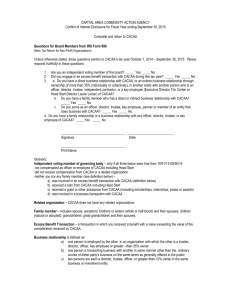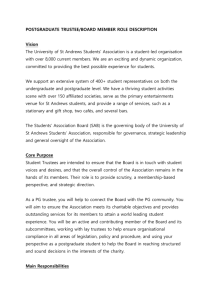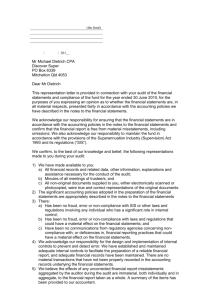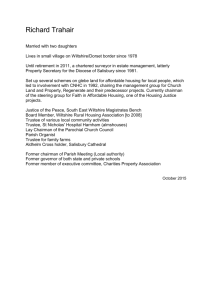Accounting for Corporate Trustees
advertisement
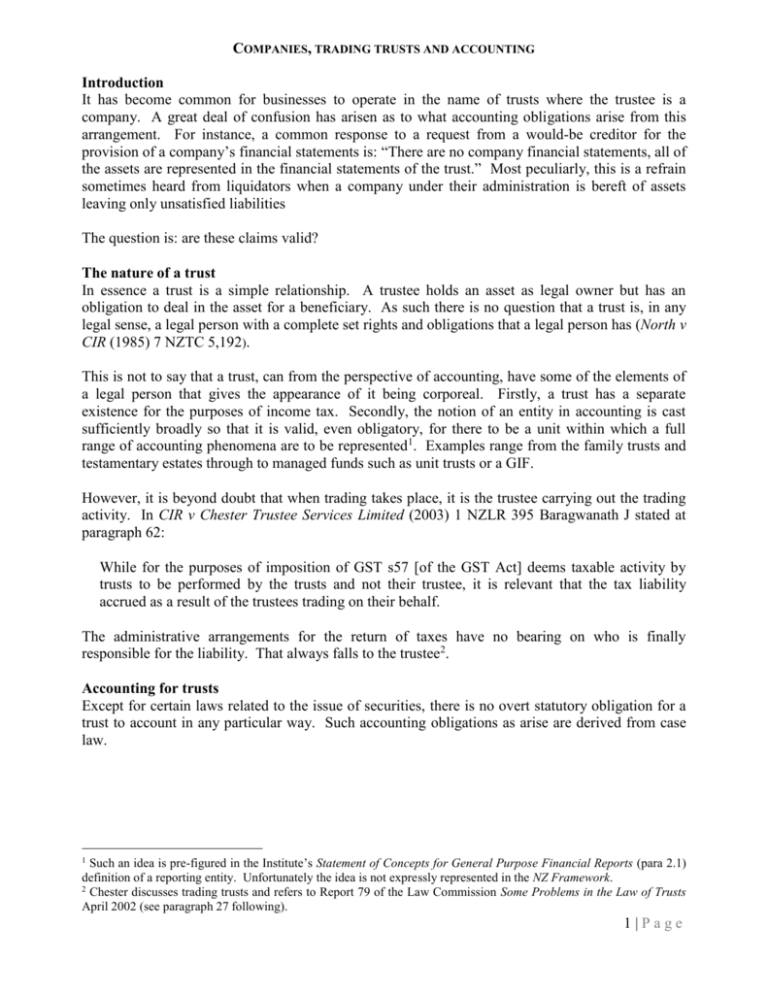
COMPANIES, TRADING TRUSTS AND ACCOUNTING Introduction It has become common for businesses to operate in the name of trusts where the trustee is a company. A great deal of confusion has arisen as to what accounting obligations arise from this arrangement. For instance, a common response to a request from a would-be creditor for the provision of a company’s financial statements is: “There are no company financial statements, all of the assets are represented in the financial statements of the trust.” Most peculiarly, this is a refrain sometimes heard from liquidators when a company under their administration is bereft of assets leaving only unsatisfied liabilities The question is: are these claims valid? The nature of a trust In essence a trust is a simple relationship. A trustee holds an asset as legal owner but has an obligation to deal in the asset for a beneficiary. As such there is no question that a trust is, in any legal sense, a legal person with a complete set rights and obligations that a legal person has (North v CIR (1985) 7 NZTC 5,192). This is not to say that a trust, can from the perspective of accounting, have some of the elements of a legal person that gives the appearance of it being corporeal. Firstly, a trust has a separate existence for the purposes of income tax. Secondly, the notion of an entity in accounting is cast sufficiently broadly so that it is valid, even obligatory, for there to be a unit within which a full range of accounting phenomena are to be represented1. Examples range from the family trusts and testamentary estates through to managed funds such as unit trusts or a GIF. However, it is beyond doubt that when trading takes place, it is the trustee carrying out the trading activity. In CIR v Chester Trustee Services Limited (2003) 1 NZLR 395 Baragwanath J stated at paragraph 62: While for the purposes of imposition of GST s57 [of the GST Act] deems taxable activity by trusts to be performed by the trusts and not their trustee, it is relevant that the tax liability accrued as a result of the trustees trading on their behalf. The administrative arrangements for the return of taxes have no bearing on who is finally responsible for the liability. That always falls to the trustee2. Accounting for trusts Except for certain laws related to the issue of securities, there is no overt statutory obligation for a trust to account in any particular way. Such accounting obligations as arise are derived from case law. Such an idea is pre-figured in the Institute’s Statement of Concepts for General Purpose Financial Reports (para 2.1) definition of a reporting entity. Unfortunately the idea is not expressly represented in the NZ Framework. 2 Chester discusses trading trusts and refers to Report 79 of the Law Commission Some Problems in the Law of Trusts April 2002 (see paragraph 27 following). 1 1|Page In both Freeman v Fairlie [1812] [3. Mer. 29] and Springett v Dashwood [1860] [S.C. 3 L.T. 542; 7 Jur. (N.S.) 93.] the Courts held that: “It is … the bounden duty of an Executor to keep clear and distinct accounts of the property which he himself is bound to administer …” The phrase ‘clear and disctint’ is prone to being misconstrued. In both of these cases the trustee had lost track of assets held in trust. The duty imposed is to keep separation in the sense of a general ledger to enable the trustee to fulfil his or her obligations in respect to trust property. In short, the trustee must know what assets are subject to trust to enable a proper administration on behalf of the beneficiary. The requirement to be ‘clear and distinct’ is not a commentary on the compilation of financial statements as it has been taken to mean. This confusion arises from the unfortunate colloquialism which would have the terms ‘financial statements’ and ‘accounts’ as being synonymous. They are not. Accounts are the forum within which detailed double entry takes place. Financial statements are the summarised abstraction from the accounts to be presented in a prescribed format together with additional information. The Courts did not contemplate the preparation of financial statements in the modern sense. Even if they did it would not matter much. That an entity that is a trust is to be accounted for separately in a financial report is not incompatible with the notion of that reporting entity being a sub-set of a wider reporting entity that is the trustee. This idea that one entity, legal or otherwise, is to be combined with another to give a proper economic perspective is established practice in the form of consolidation procedure. The foundation of a trust as a business A trading trust with a corporate trustee may be seen as coming into being in one of two ways. First, it is possible that a settlor subjects the substantive property of a business (financial assets, inventory, plant etc.) to a trust and appoints a company, incorporated for the purpose or otherwise, to be trustee (this will be referred to as the first case). From the perspective of accounting notation, there is an asset as the debit with a trust fund representing the credit. It is not without significance that the trust deed will give overt recognition to the credit in the mention of the trust fund. The second possibility (being the second case) is the more problematic. Frequently, a trust is established with a peppercorn settlement of say $10. There are even cases where the settlement is as little as $1. In both cases the trust, or more correctly the trustee, will be granted the range of powers in the trust deed to conduct a business: borrow, lend, buy, sell and so on. There needs to be specification of the beneficiaries. These may be specified persons or at the discretion of the trustee or both. It is necessary to note that the general rule is that a trustee has a right of indemnity to the trust assets. On occasion some trust deeds are configured to deny this right to the trustee if the trustee is a corporation. It is not the purpose here to consider the validity of such exclusion clauses. However, suffice to say that as the argument progresses it will become evident that, if effective, such exclusion clauses constitute an immediate breach of the general duties imposed on the director of the trustee companies by Part VIII of the Companies Act 1993. The accounting duties of companies All companies are subject to the Financial Reporting Act 1993. This Act variously imposes an obligation to prepare financial statements in accordance either with generally accepted accounting (GAAP) practice or, for exempt companies, with the formats laid out in the Financial Reporting Order 1994 (FRO94). Without wishing the distraction of an analysis of the effect of FRO94, 2|Page suffice to say that the implied obligation in the FRO94 formats to report on assets and liabilities has a similar effect to those obligations imposed on companies which are not exempt. As matters stand it is difficult to future proof any commentary on the obligations of all companies, particularly if closely held, given the proposed revision3. Companies subject to GAAP are currently either subject to International Financial Reporting Standards (IFRS) or the New Zealand Financial Reporting Standards. What can be said with confidence is that so long as fundamental provisions of the Companies Act 1993 depend on some sort of formal determination of financial position a statement for that purpose will be required. These provisions overtly include section 4 in regard to the solvency test and the record keeping requirements of section 1944. Tacitly a formal determination of financial position informs such obligations as arise under Part VIII of the Companies Act. It is therefore assumed that the basic measurement and recognition principles that pervade GAAP will endure beyond a revision of the reporting obligations of closely held companies. It can be seen that the obligations of companies will always entail a determination of financial position that achieves the following: The recognition of assets where substantively owned at no greater value than their economic worth. The recognition of liabilities where there is a present obligation at an economically valid value. A residual value that represents equity. Another way of saying this is to assert that the principles outlined in the various versions of the conceptual framework will endure beyond any revision of the detailed financial reporting rules. Accounting for the affairs of trusts and corporate trustees – the first case At inception To consider an example, suppose a settlor settled trading assets on a trust to a value of $100,000. The trustee is Company X which has been incorporated for the purpose with no capital. Company X will establish a general ledger and make the following entry: Dr Cr Assets Trust fund $ 100,000 $ 100,000 From this entry a balance sheet can be derived as follows: $ Assets Various 100,000 Liabilities + equity Trust fund 100,000 Whose is this balance sheet? It certainly could be said to be the trust’s balance sheet. Is it also Company X’s balance sheet? The answer might depend upon the application of the asset and 3 4 See Release 9 which talks about a review in mid-2008 with the possibility of a new regime in ‘a few years’. See also section 22 of the Tax Administration Act 1994. 3|Page liability definitions set out in the Statement of Concepts (or the NZ Framework which is sufficiently similar for this purpose). Taking the assets first, it can be seen that the assets are both owned and controlled by Company X. They can be assumed to encompass economic benefit (value). They arose as a ‘past event’ which is the act of settlement. It is obligatory that they are represented in the balance sheet of Company X.5 The trust fund is more problematic. At one level there is an obligation – that of trustee to the beneficiaries. At some stage there will be an outflow of funds. Again the past event is the settlement6. Again it is obligatory for Company X to recognise the liability. The balance sheet is also that of Company X. The trust fund may be problematic as a liability when company law is considered. It could be shown that no distribution can take place without a declaration of solvency in accordance with section 4. In that case the obligation may be seen to be incomplete if solvency cannot be declared. The trust fund could then be seen to inhabit that same ‘no man’s land’ that afflicts the classification of ‘shareholder current accounts’. The point is, though, the credit must appear in Company X’s financial position in some form. The detailed accounting arrangements are irrelevant to this consideration. Whether Company X kept a separate general ledger or a separate segment within its own ledger does not affect the reporting. In the first instance a consolidation is necessary to present Company X’s position. In the second instance a self-contained extract from the general ledger of Company X is necessary if and when it is thought appropriate to report to the beneficiaries. After inception Amongst the infinite variations that might follow, one simple scenario may be that a profit is made – say, $10,000 upon which tax is to be allowed of $3,300. There is likely to be general agreement that the accounting is, at least, as follows (income statement omitted): Dr Cr Assets Trust fund $ 10,000 Dr Cr Trust fund Tax allowance $ $ 10,000 3,300 $ 3,300 $ 3,300 More contentiously a third entry may be added as follows: Dr Cr Assets (of the trustee) Assets (of the trust) $ 3,300 [This accounting assumes that the trust is represented in a separate segment of Company X’s ledger and not on the existence of a separate ledger where there would be a need for more entries.] The following balance sheets arise: 5 6 SC para 7.7 SC para 7.10 4|Page Trust Assets Various Liabilities + equity Trust fund Tax allowance Other $ $ Consol. $ 106,700 3,300 110,000 106,700 106,700 3,300 3,300 106,700 3,300 110,000 If the accounting is limited to the first two journals, then the position described as consolidated would represent the trust’s position. If the third entry is accepted then the trust balance sheet is represented under the heading Trust. It is clear that a trust, not being a person to whom a liability attaches, cannot have a liability (see discussion of Chester and North above). Notwithstanding the legal position, preparers routinely prepare financial reports reflecting liabilities. Unit trusts are an example of this practice. This approach essentially relies upon the doctrine of substance over form. Even if the trust fund as a liability in the hands of the trustee could be questioned, the tax liability cannot be. It unequivocally belongs to Company X. It is mandatory under GAAP that this liability be reflected in the financial statements of the company. That this is the case can be brought into stark relief if it is imagined that the assets suffer a catastrophic failure in value (e.g. are destroyed by fire without insurance cover). A liability remains uncovered by assets. There is no trust to record the liability even if it was possible for a trust to be obligated. The mischief of the exclusion clause is plain to see. For Company X to be denied access to the assets to meet the liabilities would be to condemn it to insolvency from the very inception. It is the view of the author that a trust is defined by the existence of a trust fund. As the fortunes of the assets ebb and flow the trust fund fluctuates in harmony. At the point of extinction of the assets the trust fund ceases and there is no trust. This appears strange to the legal mind. But in the accounting mind it is central. A trust cannot exist without there being an asset to be entrusted. Accounting is the ideal forum within which to understand this simple fact. Accounting for the affairs of trusts and corporate trustees – the second case At inception Assume in the second case that there is a trust established with a peppercorn settlement – say $1. A company, Company Y, is incorporated for the purpose of the being the trustee with no capital. Money is lent for the purpose of acquiring land and undertaking development. The sum is $100,000. The accounting is as follows: Dr Cr Assets (of the trust) Trust fund $ 1 $ 1 5|Page Dr Cr Cash Loan $ 100,000 $ 100,000 Resulting in a balance sheet as follows: Trust Assets Cash Other Liabilities + equity Trust fund Loan7 Other $ $ Consol. $ 1 1 100,000 100,000 100,000 1 100,001 1 1 100,000 100,000 1 100,000 100,001 This time an accounting to the beneficiaries is problematic. Again the choices are the column labelled Trust or the consolidated position. If a trust is defined by its trust fund then the first is correct. For the second position to prevail the cash must be said to be in trust. This is where the accounting insight is at its most powerful. The cash is not represented in the trust fund. For it to be so the lender must settle their interest on the trust, an unlikely scenario. After inception Assume now that trading takes place. All of the cash is expended and a GST input of $11,111 is claimed. Interest expense of $10,000 arises. The development is sold for $110,000, including GST outputs of $12,222. The following accounting entries arise (income statement omitted): Dr Equity GST Cash $ 88,889 $ 11,111 Dr Cr Cash Equity GST $ 110,000 Dr Cr Equity Loan $ 10,000 Dr Cr Loan Cash $ 110,000 Cr $ 100,000 $ 97,778 $ 12,222 $ 10,000 $ 110,000 Giving a balance sheet as follows: Trust Other Consol. 7 Typically such borrowing is classified as a loan. However, given thin capitalization principles, a preferable view is that some or all of the loan is equity. 6|Page Assets Cash Other Liabilities + equity Trust fund Loan GST Equity $ $ $ 1 1 - 1 1 1 1 1,111 (1,111) - 1 0 1,111 (1,111) 1 [Note: the trust fund will have been extinguished at some stage if, indeed, the $1 was contributed.] There is no question that the liability belongs to Company Y and must be reflected in its financial statements. Company Y is insolvent and will be liquidated. The trust obligation does not enter into reckoning. If it is the case that the GST is the responsibility of Company Y now, it was always the case. The trust as trading entity is an illusion. To present the consolidated position as in some way related to a trust is to defy the basics of the trust relationship. The trust simply does not owe the GST shortfall nor therefore could it ever have owed it even if the cash was still available to settle it. For a liquidator to proclaim that the company did not have anything to report financially is at variance with the most basic laws. There does come a time when the legal position does trump the doctrine of substance over form. Consequences It should be noted that a tax loss has arisen. An important question is: who does it belong to? Under tax law this is important. If the loss belongs to the trust it could be utilised by a distribution from a profit making trust. Thereby income tax relief can be obtained8. Because the liability belongs to Company Y the deficit on equity must also belong to Company Y. There is conceivably an asset – a deferred tax asset. If this is so, and the law may not recognise this as an asset in that it cannot be ‘turned to account’, then the asset belongs to Company Y. To utilise the loss Company Y must either be part of a legitimate tax group or make future profits. If profits are made in future, the first claim on them will be the GST liability. If the loss is subject to group relief the compensation paid will contribute to the satisfaction of the GST liability. Conclusion Even if there was a legitimate settlement on a trust where there is a corporate trustee, the affairs of the trust are still to be represented in the balance sheet of the corporate trustee. There is no conflict in the preparation of a trust balance sheet which then forms the basis to the company’s balance sheet. Business combinations of this sort are routine in accounting. 8 At the expense, of course, of having to meet the GST liability, but that is another matter. 7|Page Where the settlement is tantamount to a sham, there is no trust encompassing the vast majority of assets. It is likely that the substantive balance sheet belongs to the corporate trustee and the corporate trustee alone. Robert B Walker 8|Page




